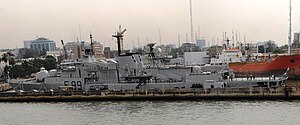Aradu (F89)
 |
|
| History | |
|---|---|
|
|
|
| Name: | Aradu |
| Builder: | Blohm & Voss, Hamburg |
| Laid down: | 1 December 1978 |
| Launched: | 25 January 1980 |
| Commissioned: | 20 February 1982 |
| Status: | Out of service |
| General characteristics | |
| Displacement: | 3,360 tons full load |
| Length: | 125.6m |
| Beam: | 15m |
| Draught: | 5.8m |
| Propulsion: | 2 Rolls-Royce TM3B gas turbines; 50,880 hp (37,940 kW), 2 MTU 20V 956 TM92 diesels; 10,420 hp (7,770 kW), 2 shafts |
| Speed: | 30.5 knots (56.5 km/h) |
| Range: | 6,500nm at 15 knots (28 km/h) |
| Complement: | 195 (26 officers) |
| Sensors and processing systems: |
Lessey AWS 5 air/surface search radar, Recal Decca 1226 navigation radar, Signall STIR fire control radar, Atlas Elektronik sonar |
| Electronic warfare & decoys: |
Two chaff dispensers, Decca RDL-2 ESM |
| Armament: | 8 x Otomat Mk 1 SSM, 24 x Aspide SAM in octuple launcher, 1 x 5 inch gun OTO Melara Otobreda 127/54 Compact, 8 x Bofors 40 mm gun, 6 x torpedo tubes, 1 depth charge rack |
| Aircraft carried: | 1 x Lynx Mk.89 (being re-activated) |
Aradu (F89) (meaning "thunder" in Hausa) is a Nigerian frigate. She is the first of the MEKO 360 General Purpose frigates built by the German Blohm + Voss company of Hamburg.
The 125.6 m ship is the biggest in the Nigerian Navy. She is a multi-purpose frigate with capabilities for anti-air, anti-surface and anti-submarine warfare effectively, and participated in the 200th anniversary celebrations of the Battle of Trafalgar. The ship also possesses capability for naval fire support and electronic warfare. Additionally, she carries a ship-borne helicopter for anti-submarine warfare, search and rescue, and enhanced surveillance/detection.
The ship is unique in the adoption of the modular approach in the design of hull and the containerization of armaments. By the modular design concept, various sections of the hull of Aradu are built to specific measurements separately and then assembled at a shipyard. The advantage of this style of construction is that every section of the ship can be produced independent of the other sections. In case of damage, it is thus easier to replace the affected section of the ship separately and then fixing it back at a shipyard. This same flexibility is adopted in the armament of the ship. These are kept in containers and can be tested ashore independent of the various stage of construction. Once the hull is ready, the containerized armaments are then easily fitted into the hull the same procedure adopted in case of major repair or replacement.
The MEKO class of ships is thus able to proceed on other missions while defective units are left for repairs at workshops. This is different from other designs where the ship for example has to sacrifice other missions in order to repair or replace a unit of her armament. Another advantage is that with the Meko concept, whole sections of the ship can be produced and stored as spares. In case of emergency, the ship simply enters a dockyard to replace whatever section that is needed. Modernization of armaments and systems can thus take place with minimum interruption to the ships' program.
The need to have a modern sophisticated frigate to complement and eventually replace Nigerian Navy's long serving frigate, NNS Nigeria (now Obuma) became apparent to naval planners in the mid-1970s. The old lady, as NNS Nigeria, was popularly known then was fast becoming irrelevant in the fast changing world of naval technology. Nigerian Navy needed to reach blue waters with the appropriate ships in terms of firepower, extended operational range and enhanced surveillance capability. NNS Aradu became the answer to these aspirations. The ship initially named The Republic was ordered in 1978. Her keel was laid in December 1978 and she was launched on 25 January 1980. In November of the same year, following a new policy of the Nigerian Navy was renamed Aradu. It was commissioned on 22 February 1982. Aradu was acquired by the regime of former President Shehu Shagari in 1982. She was recently refitted, refurbished and equipped after being alongshore for over 12 years. The ship proved it was still seaworthy by taking part in celebrations commemorating the 200th anniversary of the Battle of Trafalgar by sailing to Great Britain in 2005. The ship, which carries a crew of about 250 officers and men, requires 500,000 litres of petrol per voyage.
...
Wikipedia
